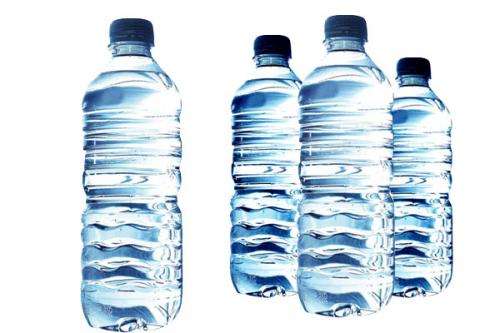(Phys.org) —A team of researchers in Germany has identified an endocrine-disrupting chemical (EDC) found in samples taken from commercial bottled water. In their paper published in PLoS ONE, the team describes the methods they used to isolate the EDC found in the water samples.
EDCs (man-made compounds used in many plastics) have been found to interfere with hormonal systems in several types of organisms—particularly in reproductive and development activities. They have come to light as it has been determined that several types of EDCs are present in plastics that are used to store food or water. Bisphenol A is one such notorious chemical that was until recently found in the plastic makeup of baby bottles. In this new effort, the researchers sought to determine if there were EDCs seeping into water consumers buy in bottles, and if so, which ones they might be.
The researchers started by collecting data gathered by other researchers and medical entities. They looked for specific instances of antiestrogenic and antiandrogenic activity among 18 bottled water products. They found that 13 of the samples displayed antiestrogenic activity while 16 caused antiandrogenic activity. This confirmed their suspicions that the water samples had some amounts of EDC in them. They had a lot to choose from, however, as their study revealed 24,520 different chemicals in the water samples.
To discover which EDC in particular was in the water samples, the researchers used mass spectrometric simulations to winnow down the likely candidates. This led them to di(2-ethylhexyl) fumarate (DEHF). Subsequent chemical tests on the water samples confirmed their findings.
There was one glitch in the study, however—to date, the team reports, there is evidence implicating DEHF as only being antiestrogenic, which suggests either that there is another EDC in the water, or that more research needs to be done to discern if DEHF is also antiandrogenic. The authors note also that no one really knows if DEHF is harmful to people, or if it is, how much must be present for it to present a hazard. Thus, more research must be undertaken to find out if DEHF, like Bisphenol A needs to be banned from use in plastics used to process or contain food products.
More information: Wagner M, Schlüsener MP, Ternes TA, Oehlmann J (2013) Identification of Putative Steroid Receptor Antagonists in Bottled Water: Combining Bioassays and High-Resolution Mass Spectrometry. PLoS ONE 8(8): e72472. DOI: 10.1371/journal.pone.0072472
Abstract
Endocrine disrupting chemicals (EDCs) are man-made compounds interfering with hormone signaling and thereby adversely affecting human health. Recent reports provide evidence for the presence of EDCs in commercially available bottled water, including steroid receptor agonists and antagonists. However, since these findings are based on biological data the causative chemicals remain unidentified and, therefore, inaccessible for toxicological evaluation. Thus, the aim of this study is to assess the antiestrogenic and antiandrogenic activity of bottled water and to identify the causative steroid receptor antagonists. We evaluated the antiestrogenic and antiandrogenic activity of 18 bottled water products in reporter gene assays for human estrogen receptor alpha and androgen receptor. Using nontarget high-resolution mass spectrometry (LTQ-Orbitrap Velos), we acquired corresponding analytical data. We combined the biological and chemical information to determine the exact mass of the tentative steroid receptor antagonist. Further MSn experiments elucidated the molecule's structure and enabled its identification. We detected significant antiestrogenicity in 13 of 18 products. 16 samples were antiandrogenic inhibiting the androgen receptor by up to 90%. Nontarget chemical analysis revealed that out of 24520 candidates present in bottled water one was consistently correlated with the antagonistic activity. By combining experimental and in silico MSn data we identified this compound as di(2-ethylhexyl) fumarate (DEHF). We confirmed the identity and biological activity of DEHF and additional isomers of dioctyl fumarate and maleate using authentic standards. Since DEHF is antiestrogenic but not antiandrogenic we conclude that additional, yet unidentified EDCs must contribute to the antagonistic effect of bottled water. Applying a novel approach to combine biological and chemical analysis this is the first study to identify so far unknown EDCs in bottled water. Notably, dioctyl fumarates and maleates have been overlooked by science and regulation to date. This illustrates the need to identify novel toxicologically relevant compounds to establish a more holistic picture of the human exposome.
via RSC
Journal information: PLoS ONE
© 2013 Phys.org




















